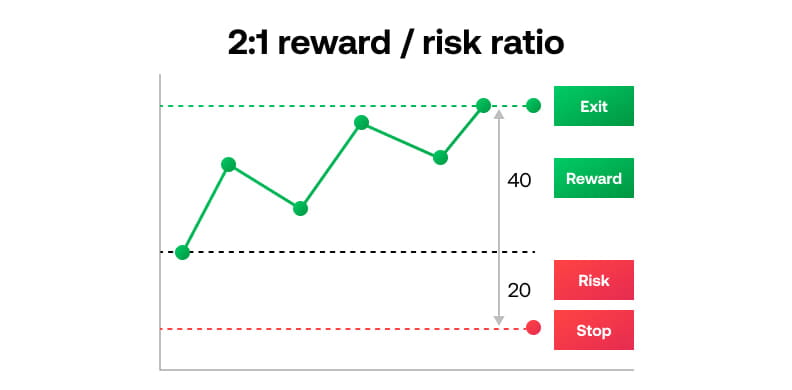
Tips for trading successfully
How to exit a trade
Knowing when to close your positions might be even more important than planning your trade entries. In this lesson, we’ll explain when to exit a trade in forex, stocks, indices and more – plus some useful trading exit strategies.
- Calculate your risk-reward ratio
- Outline your exit before your entry
- Know when to exit a position early
- Should you always stick to your take-profit order?
To trade successfully, you’ll need to master your exits. If you’re struggling with when to cut your losses – or when to take them – then follow these three steps to develop a next-level trading exit strategy that works for any asset class.
1. Calculate your risk-reward ratio
The first step when planning your trade exit is to use a risk-reward ratio, as we covered back in the first lesson of this course.
Your risk-reward ratio dictates how much profit you’ll need to target in order to justify the risk from any given position. A ratio of 1:1 means that a position with £20 of risk needs £20 potential profit, 1:2 means it would need £40 potential profit.

What is a good risk-reward ratio?
As ever on the markets, choosing your risk-reward ratio is a trade-off. That 1:1 ratio means any profits from a successful position will be immediately undone if you lose in the next one, so you’ll need a success rate north of 50% to make any money – leaving you little room for error.
Go too high with your ratio, though, and you risk limiting the opportunities you can trade. A 1:5 ratio means you only need a few successful positions to earn a healthy return, but you might struggle to find trades, effectively freezing you out of the markets. Those trades will also inevitably have a lower probability of success, leaving you vulnerable to prolonged losing streaks.
Much will depend on your chosen trading style. Position traders, for example, can target higher rewards for their risk because of the length of time they hold trades for. Day traders, on the other hand, aim to hit regular, smaller profits. So, they’ll often use a tighter ratio.
Remember, you can always tweak your risk-reward ratio if you don’t feel it is working. You could try starting out with a 1:3 ratio, then adapt if you feel it’s too tight or loose. Just try to avoid making any changes while you have a position open.
2. Outline your exit before your entry
Now that you have a risk-reward ratio in place, you’ll want to ensure that you always know your planned exits from a trade before you enter it. That means knowing when you’ll take a loss, and when you’ll claim your profit.
The use of stop losses and take profits is key here, enabling you to put your exit orders in place before you even execute your trade.
Trading exit strategies
There are several different trading exit strategies you can employ to decide when to close your position.
The simplest is to place a stop loss at the point when it has become clear that your trade has failed – for example, just below a previous level of support or resistance if you’re using the breakout method we outlined in the previous lesson. Then, you multiply the distance from your entry to the stop by your risk-reward ratio and place your limit there.
However, you’ll need to be sure that the market is likely to hit your target with a reasonable timeframe. Tools like moving averages, average true range and volume indicators can all give you an insight into the strength of upcoming moves and are worth utilising to decide whether the opportunity you’ve spotted is realistic.
You might also want to refine where you exit your trade at profit a little. You could look for nearby levels of support or resistance, for instance, where the move might peter out. Place your limit order near there, and you stand a better chance of capturing the entire trend.3. Know when to exit a position early
In general, you’ll want to try and stick to your planned exits as much as possible – but that doesn’t mean you have to hold a clearly doomed trade until it hits your stop loss. There are some scenarios in which you’ll be better off exiting early.
Unforeseen events
For example, an unforeseen event might send your market in a completely new direction. The CEO of a company you’re trading might abruptly quit, a central bank might suddenly change its monetary policy or a natural disaster could dramatically shut down a commodity’s supply.
If an event looks like it has invalidated your original strategy, then getting out now is often a better option than sticking around to see what might happen next.
Slow markets
Another instance when you might decide to quit your trade ahead of time is when the rate of price change isn’t rapid enough. Essentially, this means that while your market is heading towards your limit, but it doesn’t look like it will reach it within your chosen timeframe.
Instead of breaking your trading style, you could exit the trade once you’ve confirmed that it is moving too slowly and pocket the current profit.
Moving average crosses
Finally, moving average crossovers can offer a sign that the trend you are trading is about to end – so you might want to get out early. If a short-term moving average (MA) or exponential moving average (EMA) crosses down below a longer-term MA or EMA, then a long position could be in danger. If it crosses above, on the other hand, your short trade may be at risk.
Should you always stick to your take-profit order?
We’ve outlined a few scenarios when exiting a trade early is the right option here, but successful traders also know when to move their limit and let profits run. Head over to the next lesson to learn how.

